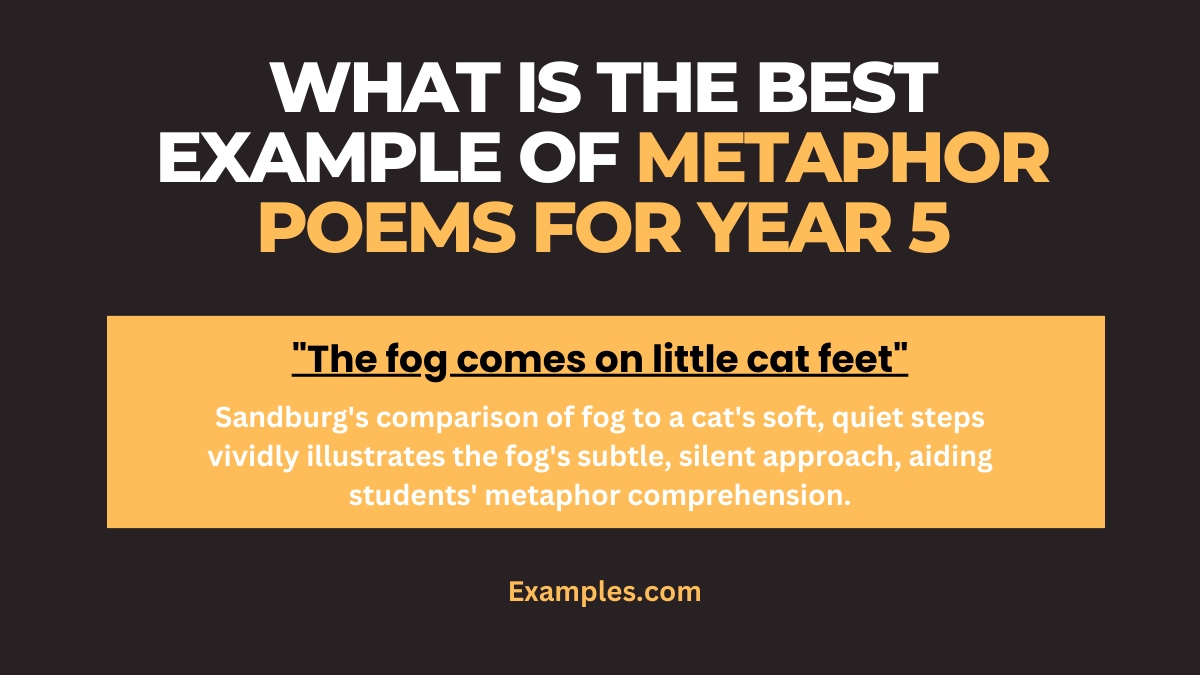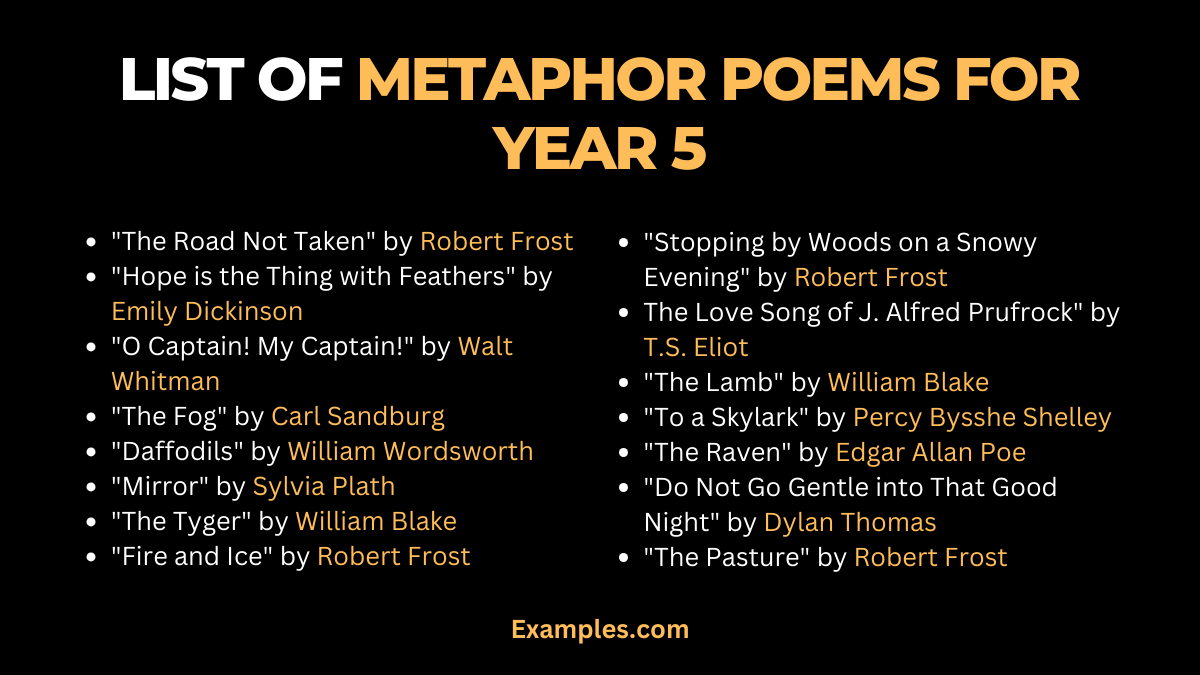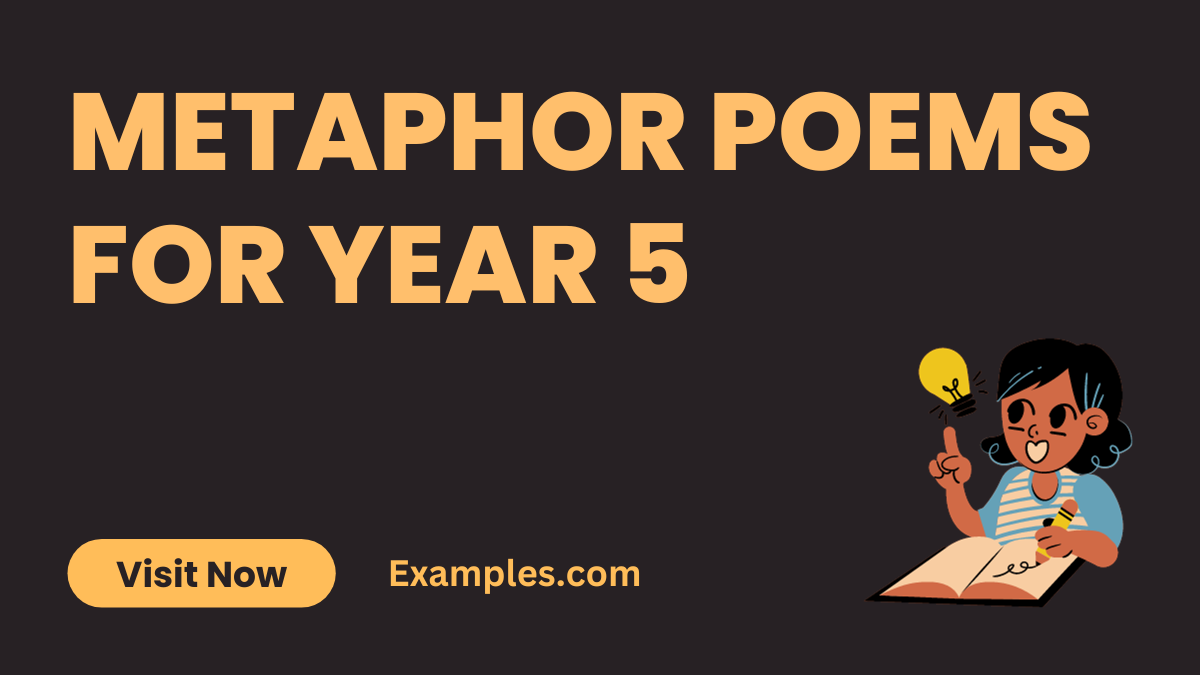14+ Metaphor Poems for Year 5 Examples
Embark on a poetic journey with our complete guide to metaphor poems for 5th grade! This resource is brimming with vibrant Metaphor Examples that are both educational and engaging. We provide a diverse array of poems that perfectly illustrate how metaphors can bring language to life, making this guide an indispensable tool for parents and teachers. Packed with tips and easy-to-understand examples, it’s designed to nurture a love for poetry and enrich language skills in young learners.
Download Metaphor Poem For Year 5 PDF
What is a Metaphor in Poetry for Year 5?
A metaphor in poetry is a figure of speech where a word or phrase is applied to an object or action to which it is not literally applicable. It’s a way of comparing two unrelated things without using “like” or “as,” which are used in similes. Metaphors are used to make descriptions more vivid and meaningful.
What is the Best Example of Metaphor Poems for Year 5?

“The Fog” is a short yet profound poem by Carl Sandburg that serves as an excellent metaphor example for Year 5 students. In this poem, Sandburg masterfully uses the metaphor of fog to describe its mysterious and transient nature. The simplicity and vivid imagery of the poem make it particularly suitable for young learners, helping them grasp the concept of metaphor in poetry.
List of Metaphor Poems for Year 5

1. “The Lamb” by William Blake
William Blake’s “The Lamb” from his collection “Songs of Innocence” is a classic example of metaphorical poetry. Through simple yet profound language, Blake explores themes of innocence and creation, using the lamb as a symbol. This poem is frequently studied in Metaphor Poems for Year 4 and Metaphor Poems for 3rd grade, offering young students an accessible introduction to metaphors.
Download Full Poem The Lamb PDF
Metaphors:
- “Lamb” – Throughout: Innocence and purity.
- “Softest clothing” – Line 2: Gentleness and care.
- “Tender voice” – Line 5: The soothing nature of innocence.
2. “To a Skylark” by Percy Bysshe Shelley
Percy Bysshe Shelley’s “To a Skylark” is a lyrical ode that elevates a bird to a symbol of beauty and inspiration. Shelley’s use of vivid imagery and metaphor makes this poem a staple in discussions of Metaphor in Literature and Simile and Metaphor. It’s particularly effective for Metaphor Poems for 5th grade and 6th grade due to its rich language and imagery.
Download Full Poem To a Skylark PDF
Metaphors:
- “Skylark” – Throughout: Unbridled joy and creativity.
- “Heavenly tune” – Line 5: Pure and sublime beauty.
- “Cloud of fire” – Line 9: Passion and vibrancy of life.
3. “The Raven” by Edgar Allan Poe
Edgar Allan Poe’s “The Raven” is a narrative masterpiece, using the raven as a symbol of mourning and despair. Its dark, atmospheric setting and the use of metaphors make it a compelling study for older students, particularly in Metaphor Poems for 6th grade and Metaphor Poems for Grade 7. It’s an excellent example of Hard Metaphor and Metaphor in Daily Life.
Download Full Poem The Raven PDF
Metaphors:
- “Raven” – Throughout: Unending grief and sorrow.
- “Midnight” – Line 7: The darkest moments of the human psyche.
- “Shadow” – Line 108: The lingering presence of loss.
4. “Do Not Go Gentle into That Good Night” by Dylan Thomas
Dylan Thomas’s villanelle is a powerful poetic plea against the inevitability of death. This poem’s use of night as a metaphor for death and rage against the dying of the light makes it an exceptional piece for discussing Metaphors for Life and Metaphors for Change. It’s suitable for Metaphor Poems for Grade 7 and as an example of Implied Metaphor Examples.
Download Full Poem Do Not Go Gentle Into that Good Night PDF
Metaphors:
- “Gentle night” – Refrain: Acceptance and tranquility in death.
- “Rage” – Refrain: The struggle against the dying of the light.
- “Good night” – Refrain: The end of life.
5. “Because I could not stop for Death” by Emily Dickinson
Emily Dickinson’s poem personifies death as a courteous gentleman, offering a unique perspective on the end of life. Its metaphorical representation of death and the journey of life makes it a profound piece for Metaphor for Kids and an illustration of Metaphor About a Person. It’s ideal for Metaphor Poems for 6th grade and for teaching Metaphor for Schools.
Download Because I Could not Stop PDF
Metaphors:
- “Carriage” – Line 2: The journey through life.
- “Death” – Line 1: The inevitability and finality of life.
- “Setting sun” – Line 12: The passage of time and life.
6. “My Shadow” by Robert Louis Stevenson
This children’s poem explores the concept of a shadow as a playful companion. Stevenson’s charming verses make it perfect for Metaphor Poems for 3rd grade and 4th grade, helping young students understand metaphors through Family Metaphor and Simple Metaphor.
Metaphors:
- “Shadow” – Throughout: A child’s curiosity and imagination.
- “In and out” – Line 7: The constant presence and changeability of life.
- “Cowardly” – Line 12: The fears and uncertainties of childhood.
7. “The Owl and the Pussy-Cat” by Edward Lear
Edward Lear’s nonsense poem is a delightful journey into whimsy and imagination. Its metaphorical use of animals and fantastical elements makes it a great resource for Metaphor Poems for 4th grade and 5th grade, encouraging creativity and imaginative thinking
Metaphors:
- “Owl and Pussy-Cat” – Throughout: Unlikely friendships and adventure.
- “Pea-green boat” – Line 1: The unusual and imaginative.
- “Bong-tree” – Line 13: The fantastical and surreal.
8. “Where the Sidewalk Ends” by Shel Silverstein
Shel Silverstein’s poem takes young readers into a world of imagination, blurring the lines between reality and fantasy. Its metaphorical representation of childhood wonder makes it a favorite for Metaphor Poems for Year 4 and 5th grade, teaching students about Metaphors in Advertising and Popular Metaphor Examples.
Metaphors:
- “Sidewalk ends” – Title: The boundaries between reality and imagination.
- “Grass grows soft” – Line 2: The comfort and safety of childhood fantasies.
- “Moon-bird” – Line 16: The wonder and mystery of the night.
9. “The Pasture” by Robert Frost
Robert Frost’s “The Pasture” uses rural imagery to convey warmth and invitation. It’s a gentle introduction to metaphorical poetry for younger students, particularly in Metaphor Poems for 3rd grade and 4th grade, and serves as an example of Metaphor in Semantics.
Metaphors:
- “Pasture” – Title: The simplicity and beauty of rural life.
- “Water clear” – Line 2: Purity and renewal.
- “Little calf” – Line 5: Innocence and new beginnings.
10. “The Cloud” by Percy Bysshe Shelley
Shelley’s “The Cloud” personifies a cloud, symbolizing the cycle of nature. Its use of natural imagery as metaphors makes it an engaging poem for Metaphor Poems for 5th grade and 6th grade. It’s often used to teach Metaphors for Learning and Metaphors for Personality Traits.
Metaphors:
- “Cloud” – Throughout: The transient and ever-changing nature of life.
- “Thunder’s home” – Line 15: The power and unpredictability of nature.
- “Pillow” – Line 2: The softness and gentleness of natural phenomena.
Famous Metaphor Poems for Year 5
1. “The Road Not Taken” by Robert Frost
This iconic poem, written in 1916, delves into the theme of choices and their repercussions in life. It’s a perfect introduction for Year 5 students to the profound use of metaphors in poetry, often used in educational settings to discuss decision-making and personal growth.
Metaphors:
- “Two roads diverged in a yellow wood” – Opening Line: Choices in life.
- “And sorry I could not travel both” – Line 2: The inevitability of choosing one path.
- “I took the one less traveled by” – Final Stanza: Embracing unique or unconventional choices.
2. “Hope is the Thing with Feathers” by Emily Dickinson
Written around 1861, Dickinson’s poem personifies hope as a bird, making it an accessible and vivid metaphor for Year 5 students. It’s used to teach how abstract concepts can be given tangible forms through metaphors.
Metaphors:
- “The thing with feathers” – Opening Line: Hope as a bird.
- “That perches in the soul” – Line 2: Hope residing within the human spirit.
- “And sings the tune without the words” – Line 3: The silent yet persistent nature of hope.
3. “Daffodils” by William Wordsworth
Published in 1807, Wordsworth’s poem is a celebration of nature, using daffodils as a metaphor for joy and beauty. It’s often used in Year 5 to illustrate how nature can be a source of inspiration and happiness.
Metaphors:
- “A host, of golden daffodils” – Line 4: Daffodils as a joyful crowd.
- “Fluttering and dancing in the breeze” – Line 6: Daffodils personified with human-like actions.
- “They stretched in never-ending line” – Line 9: The vastness and continuity of nature’s beauty.
Short Metaphor Poems for Year 5
1. “Fog” by Carl Sandburg
Published in 1916, Sandburg’s short poem uses fog as a metaphor for mystery and quietness. It’s a superb example for Year 5 students to understand how metaphors can create vivid imagery with minimal words.
Metaphors:
- “The fog comes on little cat feet” – Line 1: Fog as a stealthy, silent creature.
- “It sits looking over harbor and city” – Line 2: Fog as an observer or sentinel.
- “Then moves on” – Final Line: The transient nature of fog.
2. “Fire and Ice” by Robert Frost
This poem, written in 1920, uses fire and ice as metaphors for human emotions. It’s a great example for Year 5 students to see how metaphors can convey complex ideas in a simple, yet powerful way.
Metaphors:
- “Some say the world will end in fire” – Line 1: Fire as a metaphor for passion or desire.
- “Some say in ice” – Line 2: Ice as a symbol of hatred or indifference.
- “I hold with those who favor fire” – Line 4: The narrator’s preference for passion.
3. “Mirror” by Sylvia Plath
Written in 1961, Plath’s poem explores themes of identity, aging, and truth through the metaphor of a mirror. This poem is particularly effective for Year 5 students as it presents a familiar object in a profound, metaphorical context.
Metaphors:
- “I am silver and exact” – Line 1: The mirror as a symbol of clarity and truth.
- “A lake” – Line 10: The mirror as a deep, reflective surface.
- “In me she has drowned a young girl” – Line 17: The mirror reflecting the changes over time.
Best Metaphor Poems for Year 5
1. “The Butterfly” by Pavel Friedmann
Written in 1942, this poignant poem uses the butterfly as a metaphor for freedom and beauty amidst darkness. It’s an excellent piece for Year 5 students to understand metaphors in a historical and emotional context.
Metaphors:
- “The last, the very last” – Opening Lines: The butterfly as the last remnant of beauty.
- “So richly, brightly, dazzlingly yellow” – Line 3: Symbolizes hope and vibrancy.
- “Only I never saw another butterfly” – Closing Line: Loss of innocence and beauty.
2. “The Owl and the Pussy-Cat” by Edward Lear
Published in 1871, this charming poem uses the unlikely pairing of an owl and a cat to explore themes of adventure and love. It’s an excellent metaphorical poem for Year 5, showcasing whimsical storytelling.
Metaphors:
- “The Owl and the Pussy-cat” – Title: Unconventional pair as a metaphor for accepting differences.
- “In a beautiful pea-green boat” – Line 1: Adventure and escape from the ordinary.
- “The land where the Bong-tree grows” – Line 13: A metaphorical place of wonder and whimsy.
3. “Mother to Son” by Langston Hughes
Written in 1922, Hughes’ poem uses the metaphor of a staircase to represent life’s challenges. It’s an impactful poem for Year 5, offering a powerful metaphor for perseverance and resilience.
Metaphors:
- “Life for me ain’t been no crystal stair” – Line 2: Life as a difficult journey.
- “Tacks in it, and splinters” – Line 3: Obstacles and challenges in life.
- “And places with no carpet on the floor—Bare” – Line 5: The hardships and bareness of life.
In conclusion, these best metaphor poems offer Year 5 students a window into the powerful world of poetic expression. From the tranquility of nature to the depths of human emotion, each poem serves as a unique example of how metaphors can transform ordinary language into extraordinary imagery. These selections not only enrich students’ understanding of literary devices but also broaden their appreciation of poetry’s ability to capture the complexities of life and emotion.


